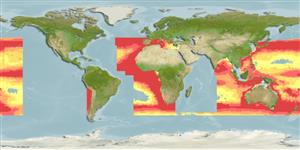Classification / Names
Common names from other countries
Main reference
Size / Weight / Age
Max length : 300 cm TL male/unsexed; (Ref. 4506)
Environment
Marine; bathypelagic; depth range 100 - 600 m (Ref. 50610)
Climate / Range
Deep-water, preferred ?; 45°N - 48°S, 76°W - 153°W
Distribution
Eastern Atlantic: western Mediterranean and from Morocco to Namibia; also off Table Bay, South Africa (Ref. 2713). Western Pacific: Japan and New Zealand. Southeast Pacific: Chile (Ref. 27363).
Countries | FAO areas | Ecosystems | Occurrences | Introductions
Short description
Dorsal
spines
(total): 0;
Dorsal
soft rays
(total): 145-184. Silvery in color except for front of head, interorbital area, dorsal part of upper jaw, and tip of lower jaw which are black (Ref. 2713). Dusky blotch usually seen on body at bases of 20-28th dorsal rays (Ref. 2713).
IUCN Red List Status (Ref. 115185)
Threat to humans
Harmless
Human uses
Fisheries: minor commercial
More information
Age/SizeGrowthLength-weightLength-lengthLength-frequenciesMorphometricsMorphologyLarvaeLarval dynamicsRecruitmentAbundance
ReferencesAquacultureAquaculture profileStrainsGeneticsAllele frequenciesHeritabilityDiseasesProcessingMass conversion
Tools
Special reports
Download XML
Internet sources
Estimates of some properties based on models
Phylogenetic diversity index
PD50 = 0.5166 many relatives (e.g. carps) 0.5 - 2.0 few relatives (e.g. lungfishes)
Trophic Level
2.9 ±0.25 se; Based on food items.
Resilience
Low, minimum population doubling time 4.5 - 14 years (Assuming tmax>10)
Vulnerability
Very high vulnerability (85 of 100)
Price category
